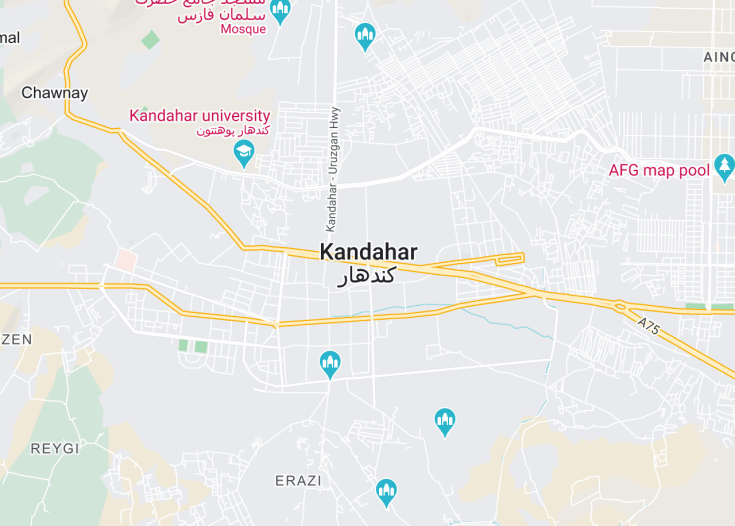Kandahar, Afghanistan’s second-largest city, is steeped in history and culture, serving as a pivotal trade center and military site since ancient times. Often recognized as the birthplace of modern Afghanistan, it boasts a rich assortment of historic architectures, vibrant bazaars, and a deep-rooted connection to the country’s storied past. Visitors can explore relics from the Alexander the Great era, the monumental Red Mosque, and the ancient walls that tell tales of a bygone era of empires and silk roads.
Check the local security advisories before planning your trip to Kandahar to ensure a safe and enjoyable experience.
Engage with a knowledgeable local guide to fully appreciate the historical significance and stories behind Kandahar’s landmarks and hidden gems.
Top things to do & see in Kandahar
Select the following sights and activities to discover best tickets and tours available in Kandahar.
Kandahar: A Gateway to Afghanistan’s Rich Heritage
| Country | Afghanistan |
| Time in Kandahar | GMT+4:30 |
| Language spoken | Pashto |
| Population | 614,118 (World Population Review) |
| Currency | Afghan Afghani (؋, AFN) |
| Airports |
|
Kandahar, the second-largest city in Afghanistan, is steeped in history and has been a significant cultural and religious center for centuries. Located in the southern region of the country, Kandahar has served as a major crossroads throughout history, linking trade routes between the Middle East and Central Asia. Its strategic importance has rendered it a pivotal location in various historical events, especially during the times of Alexander the Great and later during the rise of the Islamic empires.
Where is Kandahar?
Kandahar sits at the junction of the Southern and Central Asian regions, making it strategically significant over the centuries.
Distances:
| Route | Distance by car | Time by car |
|---|---|---|
| Kabul to Kandahar | 305 miles (491 km) | Approx. 6 hours |
| Herat to Kandahar | 383 miles (616 km) | Approx. 8 hours |
What is Kandahar famous for?
Kandahar is known for its historical architecture and cultural significance. It was the capital of the Afghan Empire and is rich in historical sites, including the Kandahar Mosque and the Mausoleum of Ahmad Shah Durrani.
History
[Ancient Times – 4th to 7th Centuries]
Kandahar, one of Afghanistan’s most ancient cities, has a robust historical narrative that spans several millennia. Its strategic location in the region of old Arachosia places it along the trade routes of the ancient Silk Road, contributing significantly to its early growth and prosperity. Archaeological findings suggest that the area was inhabited by various Indo-Iranian tribes before falling under the influence of the Achaemenid Empire around the 6th century BCE, marking its first significant period of urban development.
[Islamic Era – 7th Century Onwards]
The Islamic conquests reached Kandahar in the 7th century, introducing significant cultural and religious shifts to the region. It was during this period that Kandahar began to flourish as a center of Islamic learning and arts. The city frequently changed hands between various ruling dynasties including the Ghaznavids, Ghorids, and eventually the Timurids, each contributing to the city’s rich architectural and cultural heritage.
[Modern Era – 18th Century to Present]
Modern Kandahar was shaped significantly during the reign of Ahmad Shah Durrani, the founder of the Afghan Empire in the mid-18th century, who made it his capital. This era marked another peak in Kandahar’s development, establishing it as a pivotal political and cultural center in Afghanistan. In the contemporary period, Kandahar has witnessed various phases of modernization though it has also faced challenges, including considerable conflict due to its strategic importance. Today, Kandahar remains a testament to Afghanistan’s complex history and resilience.
Visit Kandahar
What to see and do in Kandahar
Kandahar is a city rich in history and culture, offering various attractions to its visitors. Key sites include the Red Mosque, an impressive architectural feat with intricate Islamic calligraphy, and the Kandahar Museum which houses artifacts spanning several centuries that showcase the city’s vibrant history. Nature enthusiasts may visit the Arghandab Valley, known for its lush landscapes and the Kandahar Flower, a unique species native to the area.
- Explore the ancient Citadel of Kandahar
- Visit the mausoleum of Ahmad Shah Durrani
- Shop at the bustling Shor Bazaar for traditional crafts
Annual Cultural Events in Kandahar
Kandahar hosts a variety of cultural events throughout the year that celebrate its rich heritage and vibrant local culture. The most notable is the New Year (Nowruz) celebration which takes place in March and features traditional music, dance, and a display of local crafts and cuisine. The city also observes major Islamic events with great reverence, attracting visitors from across the region.
Best time to visit Kandahar
The ideal time to visit Kandahar is during the cooler months from October to April. During this period, the weather is mild, making it more comfortable to explore the city’s extensive historical sites and participate in outdoor activities without the harsh summer heat.
Is Kandahar worth visiting?
Kandahar is undoubtedly worth visiting for those intrigued by rich cultural history and vibrant traditions. As a historical crossroads of various empires, the city offers a unique tapestry of cultural and architectural heritage that provides deep insights into the broader history of the region. Furthermore, its resilient spirit and warm local hospitality make it an enriching experience for all visitors.









